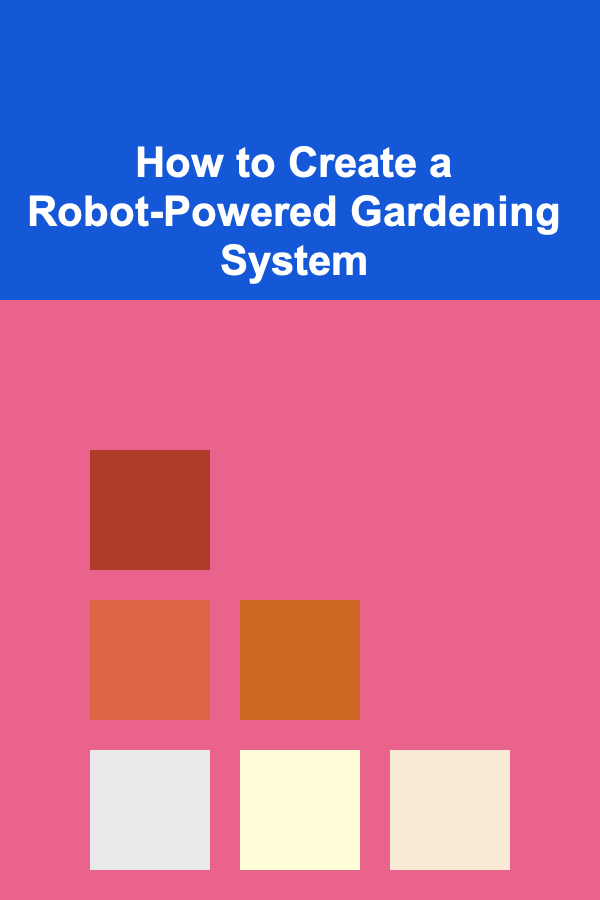
How to Create a Robot-Powered Gardening System
ebook include PDF & Audio bundle (Micro Guide)
$12.99$8.99
Limited Time Offer! Order within the next:

Gardening is an activity enjoyed by many, but it often requires significant time, effort, and care to maintain a healthy garden. The advent of robotics and automation has made its way into various industries, and gardening is no exception. With the help of robot-powered gardening systems, you can automate routine tasks, improve garden productivity, and even create more sustainable practices. This article will explore the key components involved in designing and creating a robot-powered gardening system, from understanding the needs of the garden to integrating robots into various gardening tasks.
Understanding the Components of a Robot-Powered Gardening System
A robot-powered gardening system is an ecosystem where robots perform specific gardening tasks such as planting, watering, weeding, and monitoring plant health. To design an effective system, it's important to understand the core components that make up such a system:
1.1. Sensors
Sensors are essential for gathering data from the garden environment. They allow the system to monitor various parameters like soil moisture, temperature, humidity, and light intensity. The sensors collect real-time data that helps the robot make decisions on actions to take.
Types of Sensors for Gardening:
- Soil Moisture Sensors: These detect the moisture levels in the soil, informing the robot when it's time to water the plants.
- Temperature Sensors: They monitor the ambient temperature to ensure that plants are in optimal growing conditions.
- Light Sensors: These help the robot understand the light conditions in the garden, ensuring plants get enough sunlight.
- Proximity Sensors: These are used for detecting objects in the environment to avoid collisions while the robot moves.
1.2. Actuators
Actuators are mechanical components that perform physical actions in response to signals from the sensors. They drive the movements of the robot, allowing it to perform tasks such as planting, watering, and weeding. The type of actuators used will depend on the task, and could include motors, hydraulic systems, or pneumatic systems.
1.3. Robotic Arm
A robotic arm can be equipped with various tools such as pruning shears, a trowel, or even a small shovel to perform tasks like planting, trimming, or moving objects. Robotic arms can be mounted on mobile platforms, allowing them to navigate through the garden and execute a variety of tasks.
1.4. Mobile Platform
The mobile platform is the base of the robot, allowing it to navigate through the garden autonomously. It may include wheels, tracks, or legs, depending on the terrain and the tasks the robot will be performing. Mobile platforms are often equipped with GPS or other positioning systems to help with navigation and task execution.
1.5. Artificial Intelligence (AI) and Machine Learning
AI and machine learning play a significant role in the decision-making process. AI allows the system to process data from sensors, learn from the environment, and make decisions. Machine learning algorithms enable the robot to improve its actions over time based on feedback, such as adjusting watering schedules or weeding patterns.
1.6. Power Supply
A reliable power supply is essential for the operation of robot-powered gardening systems. Most systems are powered by rechargeable batteries, solar panels, or a combination of both. Solar-powered robots are particularly beneficial for gardening, as they use renewable energy and can operate autonomously for longer periods.
Step-by-Step Guide to Creating a Robot-Powered Gardening System
2.1. Defining the Scope of the System
The first step in creating a robot-powered gardening system is to define the scope of the tasks the robot will handle. Consider the size of the garden, the type of plants you are growing, and the specific needs of the garden. Here are some common tasks that can be automated with robot-powered systems:
- Watering: Automating the watering process based on real-time data from soil moisture sensors.
- Weeding: Using a robot to detect and remove weeds.
- Planting: Automating the process of planting seeds or seedlings.
- Pruning: Using a robotic arm or attachment for trimming overgrown plants.
- Monitoring: Utilizing cameras and sensors to monitor plant health and detect any issues like pests or diseases.
2.2. Designing the Robot's Architecture
Once you have defined the tasks, you can start designing the robot's architecture. Consider the following:
- Movement: Will the robot be stationary or will it move around the garden? How will it navigate? A mobile robot with wheels is typically used for tasks like watering or weeding, whereas stationary robots may be used for specific tasks like pruning or planting.
- Tools and Attachments: Choose the tools or attachments that will be needed for various gardening tasks. A robotic arm, sprayer, or specialized weeding tool might be used, depending on your system's needs.
- Sensor Integration: Sensors should be placed strategically to monitor critical environmental parameters. Soil moisture sensors can be buried in the soil, while temperature and light sensors should be placed above the plants.
- Communication and Data Storage: Decide how the robot will communicate with you and store data. Will it be connected to an app for remote control, or will it operate fully autonomously? Data storage is essential for tracking performance and making adjustments as necessary.
2.3. Selecting the Components
With the architecture in place, you can now select the components necessary for building your robot. Below are key components to consider:
- Microcontroller: The brain of the robot that processes input from sensors and controls actuators. Popular choices include Arduino, Raspberry Pi, and ESP32.
- Motors and Actuators: These will allow your robot to move, as well as perform tasks like watering or weeding.
- Power Supply: Batteries, solar panels, or a hybrid approach can be used, depending on the size of your robot and how long you want it to operate autonomously.
- Sensors: Select sensors based on the parameters you need to monitor. Soil moisture sensors, temperature sensors, and cameras are common choices.
- AI Platform: Choose an AI platform to help with decision-making. You may use TensorFlow, OpenCV, or other machine learning libraries for object recognition and other tasks.
2.4. Building and Assembly
With all components selected, the next step is to build the robot. This will involve:
- Assembling the Frame: Build or 3D print the robot's chassis or frame, which will house the motors, sensors, and power supply. If using a mobile platform, ensure the wheels or tracks are appropriately placed for efficient movement.
- Wiring and Connecting: Connect the sensors and actuators to the microcontroller and ensure all wiring is neat and secure.
- Installing Sensors: Install the sensors in strategic locations. Soil moisture sensors should be placed in the soil, while temperature and light sensors should be positioned for optimal readings.
- Programming the Robot: Write the code that will control the robot. This code should include tasks such as data gathering from sensors, decision-making algorithms, movement control, and task execution.
2.5. Testing and Calibration
Once the robot is assembled, it's important to test and calibrate the system. Here's how you can ensure everything works as expected:
- Test Sensor Readings: Check that the sensors are accurately reading soil moisture, temperature, and light levels.
- Test Movement: Ensure the robot can navigate the garden without obstacles and perform its tasks, such as watering or weeding.
- Calibrate AI Models: If your robot uses AI for tasks like plant recognition or weed detection, ensure that the AI models are trained with enough data and are working correctly.
2.6. Integrating Machine Learning for Improved Performance
Machine learning can enhance the robot's performance over time by allowing it to learn from its environment. Here's how you can integrate machine learning:
- Data Collection: Gather data from the sensors and environment. The robot can use this data to make decisions about when to water plants, remove weeds, or prune plants.
- Training the Model: Use the data collected from the robot's operations to train machine learning models that can identify patterns, such as when soil moisture levels are low or when weeds need to be removed.
- Continuous Learning: As the robot operates, it can continue to improve by learning from new data, optimizing its actions, and increasing efficiency.
2.7. Creating a User Interface (UI)
A user interface allows you to control and monitor the robot. Consider designing an app or web-based interface where you can:
- Monitor sensor data in real time.
- Control the robot remotely for tasks like starting or stopping operations.
- Adjust settings for watering schedules, weeding times, and other functions.
- Receive alerts for issues like low battery, failed operations, or plant health issues.
2.8. Maintenance and Upgrades
Maintaining the robot is critical to ensure it continues to operate effectively. Regular maintenance tasks include:
- Cleaning the sensors to ensure accurate readings.
- Checking and recharging the power supply to prevent downtime.
- Updating the software to improve performance or add new features.
Challenges and Considerations
While creating a robot-powered gardening system is an exciting and innovative project, there are several challenges to consider:
- Cost: Building a robot-powered system can be expensive, especially if you're using high-end sensors, actuators, and AI technology.
- Weather Conditions: Robots must be designed to operate in various weather conditions. Waterproofing and temperature tolerance are key considerations.
- Power Supply: Ensuring the robot has a sufficient and sustainable power source is essential, especially for systems that require frequent use.
- Autonomy and Decision Making: Developing a robot that can make decisions about garden care without human intervention is complex and requires advanced algorithms.
Conclusion
Creating a robot-powered gardening system can significantly improve the efficiency of garden management, automate time-consuming tasks, and increase the sustainability of your garden. By leveraging the power of robotics, sensors, AI, and machine learning, you can create a highly efficient, autonomous system that will care for your garden just as well as, or even better than, you could manually. With proper planning, design, and continuous improvement, robot-powered gardening systems will play an increasingly important role in the future of sustainable gardening.
Reading More From Our Other Websites
- [Organization Tip 101] How to Store Kitchen Gadgets in a Small Drawer
- [Home Cleaning 101] How to Clean Your Mattress and Remove Dust Mites
- [Home Holiday Decoration 101] How to Add Holiday Charm to Your Front Yard
- [Organization Tip 101] How to Highlight Special Occasions with Thoughtful Jewelry Choices
- [Home Lighting 101] How to Decode Lumens vs. Watts and Choose the Perfect Brightness for Your Home
- [Personal Finance Management 101] How to Refinance a Home Loan Wisely: When It Makes Sense and When It Doesn't
- [Home Security 101] How to Use Home Security Lighting to Create a Safer Environment at Night
- [Home Pet Care 101] How to Travel with Your Pet on a Plane
- [Soap Making Tip 101] Troubleshooting Common Soap-Making Mistakes and How to Fix Them
- [Home Cleaning 101] How to Clean Your Washing Machine and Dryer

How to Improve Your Credit Score in 5 Easy Steps
Read More
How to Sell Your Antique Books at a Book Fair: A Comprehensive Guide
Read More
How to Sell Your Antique Furniture Through an Online Auction: An Actionable Guide
Read More
How to Edit Photos Like a Pro in Lightroom
Read More
Prioritizing Your Personal Life Alongside Work: A Comprehensive Guide
Read More
10 Tips for Creating a Post-Divorce Budget
Read MoreOther Products

How to Improve Your Credit Score in 5 Easy Steps
Read More
How to Sell Your Antique Books at a Book Fair: A Comprehensive Guide
Read More
How to Sell Your Antique Furniture Through an Online Auction: An Actionable Guide
Read More
How to Edit Photos Like a Pro in Lightroom
Read More
Prioritizing Your Personal Life Alongside Work: A Comprehensive Guide
Read More